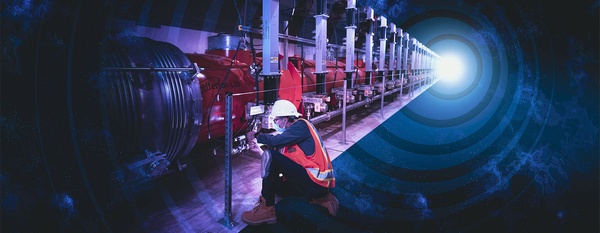Crews have successfully cooled the accelerator to minus 456 degrees Fahrenheit – or 2 kelvins – a temperature at which it becomes superconducting and can boost electrons to high energies with nearly zero energy lost in the process.
The original LCLS accelerated electrons through a copper pipe at room temperature, which limits its rate to 120 X-ray pulses per second. In 2013, SLAC launched the LCLS-II upgrade project to boost that rate to a million pulses and make the X-ray laser thousands of times more powerful. For that to happen, crews removed part of the old copper accelerator and installed a series of 37 cryogenic accelerator modules, which house pearl-like strings of niobium metal cavities. These are surrounded by three nested layers of cooling equipment, and each successive layer lowers the temperature until it reaches nearly absolute zero.

Credit: SLAC
The linac is equipped with two world-class helium cryoplants. One of the cryoplants, built specifically for LCLS-II, cools helium gas from room temperature all the way down to its liquid phase at just a few degrees above absolute zero, providing the coolant for the accelerator.
On April 15, the new accelerator reached its final temperature of 2 K for the first time and today, May 10, the accelerator is ready for initial operations.
In addition to a new accelerator and a cryoplant, the project got a new electron source and two new strings of undulator magnets that can generate both “hard” and “soft” X-rays. Hard X-rays, which are more energetic, allow researchers to image materials and biological systems at the atomic level. Soft X-rays can capture how energy flows between atoms and molecules, tracking chemistry in action and offering insights into new energy technologies.
Now that the cavities have been cooled, the next step is to pump them with more than a megawatt of microwave power to accelerate the electron beam from the new source. Electrons passing through the cavities will draw energy from the microwaves so that by the time the electrons have passed through all 37 cryomodules, they'll be moving close to the speed of light. Then they’ll be directed through the undulators, forcing the electron beam on a zigzag path. If everything is aligned just right – to within a fraction of the width of a human hair – the electrons will emit the world’s most powerful bursts of X-rays.
This is the same process that LCLS uses to generate X-rays. However, since LCLS-II uses superconducting cavities instead of warm copper cavities based on 60-year-old technology, it can can deliver up to a million pulses per second, 10,000 times the number of X-ray pulses for the same power bill.
Once LCLS-II produces its first X-rays, which is expected to happen later this year, both X-ray lasers will work in parallel, allowing researchers to conduct experiments over a wider energy range, capture detailed snapshots of ultrafast processes, probe delicate samples and gather more data in less time, increasing the number of experiments that can be performed. It will greatly expand the scientific reach of the facility, allowing scientists from across the nation and around the world to pursue the most compelling research ideas.





Comments